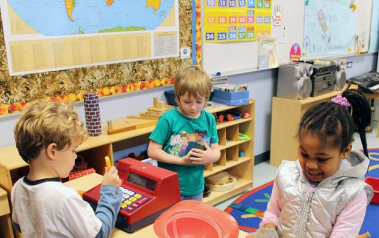9.6: Compañeros
- Page ID
- 49926
Las relaciones dentro de la familia (padre e hijo y hermanos) no son las únicas relaciones significativas en la vida de un niño. Las relaciones entre compañeros también son importantes. La interacción social con otro niño de la misma edad, habilidades y conocimiento provoca el desarrollo de muchas habilidades sociales que son valiosas para el resto de la vida (Bukowski, Buhrmester y Underwood, 2011). En las relaciones con los compañeros, los niños aprenden cómo iniciar y mantener interacciones sociales con otros niños. Aprenden habilidades para manejar conflictos, tales como tomar turnos, compromisos y negociaciones. El juego también implica la coordinación mutua, a veces compleja, de objetivos, acciones y comprensión. Por ejemplo, a medida que los preescolares participan en juegos de simulación, crean narraciones juntos, eligen roles y colaboran para representar sus historias. A través de estas experiencias, los niños desarrollan amistades que proporcionan fuentes adicionales de seguridad y apoyo a las que brindan sus padres.

Sin embargo, las relaciones entre compañeros pueden ser desafiantes y también de apoyo (Rubin, Coplan, Chen, Bowker y McDonald, 2011). Ser aceptado por otros niños es una fuente importante de confirmación y autoestima, pero el rechazo de los compañeros puede significar problemas de comportamiento posteriores (especialmente cuando los niños son rechazados debido a un comportamiento agresivo).
Las relaciones entre compañeros requieren el desarrollo de habilidades sociales y emocionales muy diferentes a las que surgen en las relaciones entre padres e hijos. También ilustran las muchas formas en que las relaciones entre compañeros influyen en el crecimiento de la personalidad y el autoconcepto.29
Contribuyentes y atribuciones
29. Children’s Development por Ana R. Leon bajo licencia CC BY 4.0


